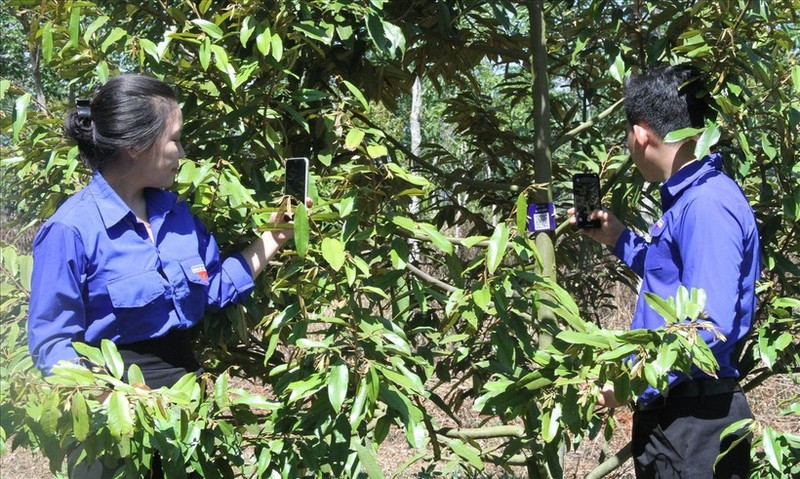Traceability as tool for brand positioning
In an increasingly competitive trade environment, product traceability not only enables businesses to maintain tight control from production to consumption, but also demonstrates transparency and a commitment to product quality.

This also aligns with the growing trend of green and safe consumption, which is becoming an irreversible movement.
Proactively demonstrating control capabilities
In 2024, Viet Nam ranked as the world's second-largest exporter of durians, behind only Thailand. However, this year, exports have declined for five consecutive months—an unprecedented occurrence. Conversely, imports of this fruit into Viet Nam have surged sixfold compared to the same period last year, with a total value approaching 10 million USD.
The main reason lies in the ongoing efforts to address pesticide residue issues in Vietnamese durians, aiming to comply with new technical and phytosanitary regulations from China and several other markets.
A few months ago, several shipments of Vietnamese black pepper exported to Taiwan (China) were found to be contaminated with Sudan Red, an industrial dye banned in food preservation and processing. These shipments were returned and widely flagged on international inspection systems. Traceability reports revealed that the pepper originated mainly from two of Viet Nam's key growing regions.
According to Hoang Thi Lien, Chairwoman of the Viet Nam Pepper and Spice Association, the presence of Sudan Red in one of the country’s key export commodities is an alarming anomaly, especially given that the use of such substances is strictly prohibited both internationally and in Viet Nam.
Beyond durians and black pepper, the European Union (EU) has recently announced plans to send inspection teams to Viet Nam to assess the control of pesticide residues in key agricultural exports such as dragon fruit and chillies. Inspectors will visit growing areas and processing-packaging facilities to check for corrective actions taken in line with food safety regulations and traceability requirements.
Worryingly, a high percentage of Vietnamese agricultural exports to the EU are subject to port-of-entry inspections: 20% for dragon fruit, and up to 50% for bell peppers and okra. Strict maximum residue limits for chemical substances and pesticides are not only enforced by the EU but also by major markets such as the US and Japan—key export destinations for Viet Nam.
Immediately following the alerts, Minister of Agriculture and Environment Do Duc Duy confirmed that Viet Nam had launched a thorough investigation and implemented comprehensive control measures across the entire “production–processing–export” chain. The findings have been compiled into reports submitted to counterpart authorities to update progress and affirm Viet Nam’s control capabilities.
Transparent accountability builds consumer trust
Once dubbed the “capital of counterfeit goods” prior to 2015, China had been notorious for producing fake versions of everything from electronics and textiles to pharmaceuticals and food. In recent years, however, the Chinese government has taken drastic action to clean up its market, resulting in a remarkable transformation. Alongside strengthening legal frameworks, China has developed specialised anti-counterfeit task forces within the police, customs and market surveillance agencies, working in tandem to dismantle large-scale networks of fake goods and substandard food products.
A key differentiator in China’s anti-counterfeiting campaign is its aggressive use of technology—particularly traceability systems on e-commerce platforms. Major players like Alibaba, JD.com, and Pinduoduo have proactively collaborated with authorities to remove violative listings, trace sources, and assist in legal enforcement.
Acknowledging China’s progress in this fight, especially regarding traceability, Luong Minh Huan, Director of the Enterprise Development Institute under the Viet Nam Chamber of Commerce and Industry, said these are valuable lessons for Viet Nam.
Clearly, traceability is not just a tool for consumers and regulators to restore transparency in the food and beverage market; it is also a technological shield and a foundation for elevating Vietnamese brands within the global value chain.
This is the message that Minister Do Duc Duy sought to convey in his role as the key figure addressing the current “crisis” in the durian industry in particular, and for Vietnamese agricultural and food products more broadly. The Minister also emphasised the importance of clarifying the roles of local authorities in quality oversight and maintaining technical standards for farming regions. Furthermore, ensuring transparency in product traceability requires meaningful engagement from not only government bodies and businesses but also from farmers themselves. The shared goal is clear: short-term quantity or profit must not come at the expense of national image and reputation.
Traditional anti-counterfeiting measures such as labels and barcodes are losing effectiveness against the sophisticated tactics of modern counterfeiters. Without robust traceability controls, Viet Nam risks becoming a blind spot for goods—a major barrier to integration.
LUONG MINH HUAN
Director of the Enterprise Development Institute








